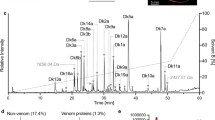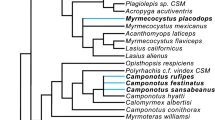Abstract
Social parasites exploit other societies by invading and stealing resources. Some enter protected nests using offensive chemical weaponry made from alkaloid-based venom. We characterized the venoms of three Megalomyrmex thief ant species (M. mondabora, M. mondaboroides, and M. silvestrii) that parasitize the fungus-growing ants, and developed an ethogram to describe host ant reactions to raiding M. mondaboroides and M. silvestrii parasites. We compared piperidine, pyrrolidine, and pyrolizidine venom alkaloid structures with synthetic samples from previous studies, and describe the novel stereochemistry of trans 2-hexyl-5-[8-oxononyl]-pyrrolidine (3) from M. mondabora. We showed that workers of Cyphomyrmex costatus, the host of M. mondaboroides and M. silvestrii, react to a sting by Megalomyrmex parasites mainly with submissive behavior, playing dead or retreating. Host submission also followed brief antennal contact. The behavior of C. costatus ants observed in this study was similar to that of Cyphomyrmex cornutus, host of M. mondabora, suggesting that the alkaloidal venoms with pyrrolidines from M. mondabora, piperidines from M. mondaboroides, and pyrolizidines from M. silvestrii may function similarly as appeasement and repellent allomones against host ants, despite their different chemical structure. With the use of these chemical weapons, the Megalomyrmex thief ants are met with little host resistance and easily exploit host colony resources.




Similar content being viewed by others
References
Adams ES, Traniello JFA (1981) Chemical interference competition by Monomorium minimum (Hymenoptera: formicidae). Oecologia 51:265–270. doi:10.1007/BF00540612
Adams RMM, Liberti J, Illum AA, Jones TH, Nash DR, Boomsma JJ (2013) Chemically armed mercenary ants protect fungus-farming societies. Proc Natl Acad Sci U S A 110:15752–15757. doi:10.1073/pnas.1311654110
Adams RMM, Longino JT (2007) Nesting biology of the arboreal fungus-growing ant Cyphomyrmex cornutus and behavioral interactions with the social-parasitic ant Megalomyrmex mondabora. Insects Soc 54:136–143. doi:10.1007/s00040-007-0922-0
Adams RMM, Mueller UG, Holloway AK, Green AM (2000a) Garden sharing and garden stealing in fungus-growing ants. Naturwissenschaften 87:491–493
Adams RMM, Mueller UG, Schultz TR, Norden B (2000b) Agro-predation: usurpation of attine fungus gardens by Megalomyrmex ants. Naturwissenschaften 87:549–554
Adams RMM, Shah K, Antonov LD, Mueller UG (2012) Fitness consequences of nest infiltration by the mutualist-exploiter Megalomyrmex adamsae. Ecol Entomol 37:453–462. doi:10.1111/j.1365-2311.2012.01384.x
Akino T (2008) Chemical strategies to deal with ants: a review of mimicry, camouflage, propaganda, and phytomimesis by ants (Hymenoptera: formicidae) and other arthropods. Myrmecol News 11:173–181
Allies AB, Bourke AFG, Franks NR (1986) Propaganda substances in the cuckoo ant Leptothorax kutteri and the slave-maker Harpagoxenus sublaevis. J Chem Ecol 12:1285–1293
Anderson AN, Blum MS, Jones TH (1991) Venom alkaloids in Monomorium “rothsteini” Forel repel other ants: is this the secret to success by Monomorium in Australian ant communities? Oecologia 88:157–160
Barke J, Seipke RF, Gruschow S, Heavens D, Drou N, Bibb MJ, Goss RJ, Yu DW, Hutchings MI (2010) A mixed community of actinomycetes produce multiple antibiotics for the fungus farming ant Acromyrmex octospinosus. BMC Biol 8:109. doi:10.1186/1741-7007-8-109
Blum MS, Jones TH, Hölldobler B, Fales HM, Jaouni T (1980) Alkaloidal venom mace: offensive use by a thief ant. Naturwissenschaften 67:144–145
Boudinot BE, Sumnicht TP, Adams RMM (2013) Central American ants of the genus Megalomyrmex Forel (Hymenoptera: Formicidae): six new species and keys to workers and males. Zootaxa 3732:1–82
Carlin NF, Hölldobler B (1987) The kin recognition system of carpenter ants (Camponotus spp.). Behav Ecol Sociobiol 20:209–217. doi:10.1007/BF00299735
Crewe RM, Blum MS (1972) Alarm pheromones of the Attini: their phylogenetic significance. J Insect Physiol 18:31–42. doi:10.1016/0022-1910(72)90062-5
Currie C, Scott J, Summerbell R, Malloch D (1999) Fungus-growing ants use antibiotic-producing bacteria to control garden parasites. Nature 398:701–705
D’Ettorre P, Errard C, Ibarra F, Francke W, Hefetz A (2000) Sneak in or repel your enemy: Dufour’s gland repellent as a strategy for successful usurpation in the slave-maker Polyergus rufescens. Chemoecology 10:135–142. doi:10.1007/PL00001815
Daly J (1995) The chemistry of poisons in amphibian skin. Proc Natl Acad Sci U S A 92:9–13
De Souza DJ, Soares IMF, Della Lucia TMC (2007) Acromyrmex ameliae sp. n. (Hymenoptera: formicidae): a new social parasite of leaf-cutting ants in Brazil. Insect Sci 14:251–257. doi:10.1111/j.1744-7917.2007.00151.x
Dijkstra MB, Boomsma JJ (2003) Gnamptogenys hartmani wheeler (Ponerinae: ectatommini): an agro-predator of Trachymyrmex and Sericomyrmex fungus-growing ants. Naturwissenschaften 90:568–571. doi:10.1007/s00114-003-0478-4
Escoubas P, Blum MS (1990) The biological activities of ant-derived alkaloids. In: Vander Meer RK, Jaffe K, Cedeno A (eds) Applied myrmecology. Westview Press, Boulder, Colorado, pp 482–489
Francke W, Schröder F, Walter F, Sinnwell V, Baumann H, Kaib M (1995) New alkaloids from ants: identification and synthesis of (3R,5S,9R)-3-butyl-5-(1-oxopropy1)indolizidine and (3R,5R,9R)-3-butyl-5-(1-oxopropyl)indolizidine, constituents of the poison gland secretion in Myrmicaria. Liebigs Ann 6:965–977
Garraffo HM, Simon L, Daly J, Spande TF, Jones TH (1994) Cis- and trans-configurations of α, α’-disubstituted piperidines and pyrrolidines by GC-FTIR; application to decahydroquinoline stereochemistry. Tetrahedron 50:11329–11338
Gorman J, Jones T, Spande T, Snelling R, Torres J, Garraffo H (1998) 3-hexyl-5-methylindolizidine isomers from thief ants, Solenopsis (Diplorhoptrum) species. J Chem Ecol 24:933–943
Guillem R, Drijfhout F, Martin S (2014) Chemical deception among ant social parasites. Curr Zool 60:62–75
Hermann H, Moser J, Hunt A (1970) The hymenopterous poison apparatus. X. Morphological and behavioral changes in Atta texana (Hymenoptera: Formicidae). Ann Entomol Soc Am 63:1552–1558
Hölldobler B (1973) Chemische strategie beim nahrungserwerb der diebsameise (Solenopsis fugax Latr.) und der Pharaoameise (Monomorium pharaonis L.). Oecologia 11:371–380
Hölldobler B, Wilson E (1990) The ants. Belknap Press of Harvard University Press, Cambridge, p 198
Ishak HD, Miller JL, Sen R, Dowd SE, Meyer E, Mueller UG (2011) Microbiomes of ant castes implicate new microbial roles in the fungus-growing ant Trachymyrmex septentrionalis. Sci Rep 1:204. doi:10.1038/srep00204
Jones T, Blum M, Howard R (1982a) Venom chemistry of ants in the genus Monomorium. J Chem Ecol 8:285–300
Jones T, Highet R, Blum M, Fales H (1984) (5Z, 9Z)-3-alkyl-5-methylindolizidines from Solenopsis (Diplorhoptrum) species. J Chem Ecol 10:1233–1249
Jones TH, Blum MS, Fales HM (1982b) Ant venom alkaloids from Solenopsis and Monomorium species recent developments. Tetrahedron 38:1949–1958
Jones TH, Blum MS, Fales HM, Brandão CRF, Lattke J (1991a) Chemistry of venom alkaloids in the ant genus Megalomyrmex. J Chem Ecol 17:1897–1908. doi:10.1007/BF00993736
Jones TH, DeVries PJ, Escoubas P (1991b) Chemistry of venom alkaloids in the ant Megalomyrmex foreli (Myrmicinae) from Costa Rica. J Chem Ecol 17:2507–2518
Jones TH, Torres J, Spande T, Garraffo H, Blum M, Snelling R (1996) Chemistry of venom alkaloids in some Solenopsis (Diplorhoptrum) species from Puerto Rico. J Chem Ecol 22:1221–1236
Jones TH, Wojciechowski T, Snelling R, Torres J, Chacón P, DeVreis P (1999) Dialkylpyrrolidines from the ants Megalomyrmex cyendyra Brandão and M. latreillei Emery. Caribb J Sci 35:310–311
Jouvenaz DP, Blum MS, MacConnell JG (1972) Antibacterial activity of venom alkaloids from the imported fire ant, Solenopsis invicta Buren. Antimicrob Agents Chemother 2:291–293
Kang S, Kim W, Moon B (1985) An effective method for the preparation of ω-bromoalkanols from α, ω-diols. Synthesis 12:1161–1162
Leclercq S, Braekman JC, Daloze D, Pasteels JM, Van der Meer RK (1996) Biosynthesis of the Solenopsins, venom alkaloids of the fire ants. Naturwissenschaften 83:222–225
Lenoir A, d’Ettorre P, Errard C, Hefetz A (2001) Chemical ecology and social parasitism in ants. Annu Rev Entomol 46:573–599
Li S, Jin X, Chen J (2012) Effects of piperidine and piperideine alkaloids from the venom of red imported fire ants, Solenopsis invicta Buren, on Pythium ultimum Trow growth in vitro and the application of piperideine alkaloids to control cucumber damping-off in the greenhouse. Pest Manag Sci 68:1546–1552. doi:10.1002/ps.3337
Longino JT (2010) A taxonomic review of the ant genus Megalomyrmex Forel (Hymenoptera: Formicidae) in Central America. Zootaxa 2720:35–58
Martin SJ, Drijfhout FP (2009) Nestmate and task cues are influenced and encoded differently within ant cuticular hydrocarbon profiles. J Chem Ecol 35:368–374. doi:10.1007/s10886-009-9612-x
Morgan ED (2004) Biosynthesis in insects. R Soc Chem Cambridge. doi:10.1039/9781847550262
Mori A, Visicchio R, Sledge M (2000) Behavioural assays testing the appeasement allomone of Polyergus rufescens queens during host-colony usurpation. Ethol Ecol Evol 12:315–322
Mueller UG (2012) Symbiont recruitment versus ant-symbiont co-evolution in the attine ant-microbe symbiosis. Curr Opin Microbiol 15:269–277. doi:10.1016/j.mib.2012.03.001
Mueller UG, Rehner SA, Schultz TR (1998) The evolution of agriculture in ants. Science 281:2034–2038
Obin MS, Vander Meer RK (1985) Gaster flagging by fire ants (Solenopsis spp.): functional significance of venom dispersal behavior. J Chem Ecol 11:1757–1768
Rabeling C, Cover SP, Johnson RA, Mueller UG (2007) A review of the North American species of the fungus-gardening ant genus Trachymyrmex (Hymenoptera: formicidae). Zootaxa 1664:1–53
Rashid T, Chen J, McLeod P (2013) Toxicity of newly isolated piperideine alkaloids from the red imported fire ant, Solenopsis invicta Buren, against the green peach aphid, Myzus persicae (Sulzer). Adv Entomol 01:20–23. doi:10.4236/ae.2013.12005
Regnier FE, Wilson EO (1971) Chemical communication and “propaganda” in slave-maker ants. Science 172:267–269
Ruano F, Devers S, Sanllorente O, Errard C, Tinaut A, Lenoir A (2011) A geographical mosaic of coevolution in a slave-making host-parasite system. J Evol Biol 24:1071–1079. doi:10.1111/j.1420-9101.2011.02238.x
Saporito RA, Garraffo HM, Donnelly MA, Edwards AL, Longino JT, Daly JW (2004) Formicine ants: an arthropod source for the pumiliotoxin alkaloids of dendrobatid poison frogs. Proc Natl Acad Sci U S A 101:8045–8050. doi:10.1073/pnas.0402365101
Schoenian I, Spiteller M, Ghaste M, Wirth R, Herz H, Spiteller D (2011) Chemical basis of the synergism and antagonism in microbial communities in the nests of leaf-cutting ants. Proc Natl Acad Sci U S A 108:1955–1960. doi:10.1073/pnas.1008441108
Schultz TR, Brady SG (2008) Major evolutionary transitions in ant agriculture. Proc Natl Acad Sci USA 105:5435–5440
Schultz TR, Bekkevold D, Boomsma JJ (1998) Acromyrmex insinuator new species: an incipient social parasite of fungus-growing ants. Insects Soc 45:457–471. doi:10.1007/s000400050101
Seipke RF, Barke J, Brearley C, Hill L, Yu DW, Goss RJM, Hutchings MI (2011) A single Streptomyces symbiont makes multiple antifungals to support the fungus farming ant Acromyrmex octospinosus. PLoS ONE 6:e22028. doi:10.1371/journal.pone.0022028
Shik JZ, Kaspari M (2010) More food, less habitat: how necromass and leaf litter decomposition combine to regulate a litter ant community. Ecol Entomol 35:158–165. doi:10.1111/j.1365-2311.2009.01165.x
Snyder AJ, Jones TH, Snelling GC, Snelling RR (2009) Venom alkaloids from some Monomorium species. J Hymenopt Res 18:145–150
Soler J, Martínez J, Soler M, Møller A (2001) Life history of magpie populations sympatric or allopatric with the brood parasitic great spotted cuckoo. Ecology 82:1621–1631
Svensson EI, Råberg L (2010) Resistance and tolerance in animal enemy-victim coevolution. Trends Ecol Evol 25:267–274. doi:10.1016/j.tree.2009.12.005
Termonia A, Pasteels JM, Windsor DM, Milinkovitch MC (2002) Dual chemical sequestration: a key mechanism in transitions among ecological specialization. Proc R Soc B Biol Sci 269:1–6. doi:10.1098/rspb.2001.1859
Vander Meer RK (2012) Ant interactions with soil organisms and associated semiochemicals. J Chem Ecol 38:728–745. doi:10.1007/s10886-012-0140-8
Ward PS, Brady SG, Fisher BL, Schultz TR (2015) The evolution of myrmicine ants: phylogeny and biogeography of a hyperdiverse ant clade (Hymenoptera: formicidae). Syst Entomol 40:61–81. doi:10.1111/syen.12090
Wheeler WM (1907) The fungus-growing ants of North America. Bull Am Mus Nat Hist 23:669–807
Zamora-Munoz C, Ruano F, Errard C, Lenoir A, Hefetz A, Tinaut A (2003) Coevolution in the slave-parasite system Proformica longiseta-Rossomyrmex minuchae (Hymenoptera: formicidae). Sociobiology 42:299–317
Acknowledgments
We thank the Smithsonian Tropical Research Institute and the Organization for Tropical Studies and La Selva Biological Station in Costa Rica for providing facilities and logistical help; the Autoridad Nacional del Ambiente y el Mar and Ministerio de Ambiente, Energía y Telecomunicaciones for permission to sample ants and to export them. We thank Rozlyn E. Haley for illustrations in Fig. 1. This work was funded by a Marie Curie International Incoming Fellowship (237266 – ANCEPS) and National Science Foundation DDIG award DEB-0508698 to RMMA and DEB-0072702 (Project ALAS) to JTL. THJ acknowledges the support of the VMI Chemistry Department. Some collections and field assistance were generously provided by Janni Larson, Christian Peeters, Hermógenes Fernández-Marín, Adam Kay, and Gaspar Bruner, while Janni Larson and Astrid Blok van Witteloostuijn cared for the live colonies. Phil Lester and two anonymous reviewers provided helpful comments.
Author information
Authors and Affiliations
Corresponding author
Electronic supplementary material
Below is the link to the electronic supplementary material.
ESM 1
(DOCX 17 kb)
Rights and permissions
About this article
Cite this article
Adams, R.M.M., Jones, T.H., Longino, J.T. et al. Alkaloid Venom Weaponry of Three Megalomyrmex Thief Ants and the Behavioral Response of Cyphomyrmex costatus Host Ants. J Chem Ecol 41, 373–385 (2015). https://doi.org/10.1007/s10886-015-0565-y
Received:
Revised:
Accepted:
Published:
Issue Date:
DOI: https://doi.org/10.1007/s10886-015-0565-y




